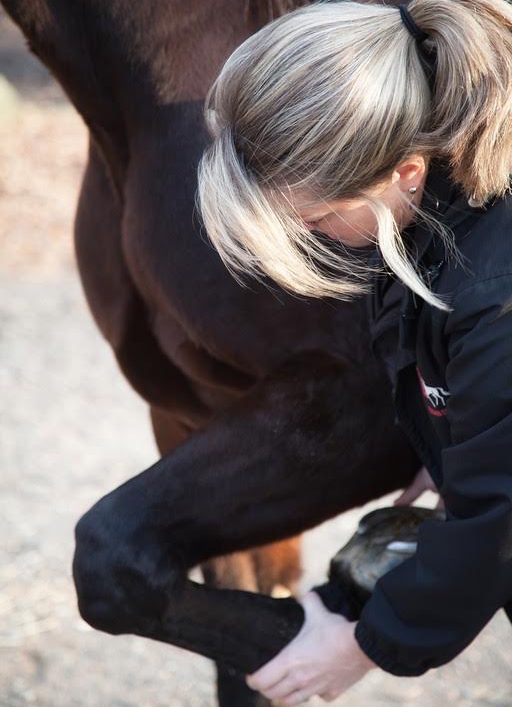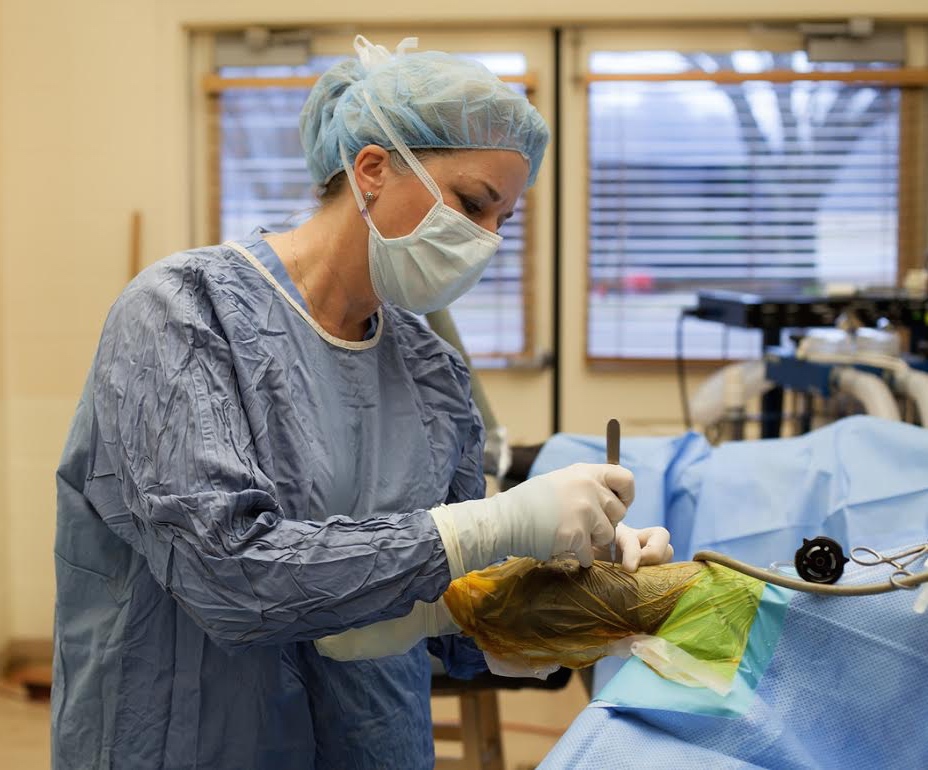There are many red-flag phrases in the playbook for horse shoppers. ‘Lag screw fixation’ should not be one of them.
So explains top veterinary surgeon Dr. Patricia Hogan, a seasoned equine veterinarian who has performed lag screw fixation—a surgical technique used to mend fractures—on many Thoroughbreds, including the great Take Charge Indy.
In this week’s Veterinary Answers column, Hogan, a former board member of the Thoroughbred Retirement Foundation (TRF), who performs charitable work for both the TRF and other equine charities, explains the technique of mending leg fractures, and offers insights on what the presence of screws means and does not mean in terms of an equine’s wellbeing.
“It’s such a misconception that horses who have screws are somehow devalued, or less sound than other horses,” Hogan says. “In most cases, it’s completely not the case. The presence of screws only means they’ve suffered an injury, which has been surgically repaired. Fractures that are repaired with screws heal fantastically, so well in fact that the affected bone is most likely the strongest bone in their body.”
Q: What is lag screw fixation?
Lag screw fixation has been around for 40 years or more. It’s minimally invasive (meaning screw placement requires only a small stab incision) and very effective at obtaining compression of the fracture.
It’s similar to a carpentry technique, where you take two pieces of wood, (or bone), and using carpentry principles, those pieces are “lagged” together.
It’s a surgical technique that has been entrenched in orthopedics for humans and horses. The nice thing about its effectiveness regarding the treatment of horses, who have major orthopedic challenges due to their size and need to remain mobile after surgery (so they don’t develop complications such as laminitis), is that we can fix a fracture with this method, and the fracture is then immediately stabilized, and thus the horses are weight-bearing. One of the major challenges with fracture fixation in horses, is that we have to stabilize fractures in a way that ideally does not require prolonged immobilization, or even a cast.
Q: Does lag screw fixation surgery get complicated?
By and large, in racehorses who experience a typical racing-related fracture, lag screw fixation is the ideal surgical method of repair, is fairly simple and routine, and in most cases, achieves the best possible outcome.
But there are degrees of difficulty in the types of fracture we see. Displaced condylar fractures, where part of the cannon bone has separated and commonly splinters, is a more challenging surgery but still amenable to lag screw fixation.
A second type and location, which can be very complicated, is in a slab fracture of the knee. There are very small bones in the knee, and they need to be mobile and the horse needs to be able to bend the knee. We use lag screws there as well, but it’s a bit more complicated because there can be a lot of small fragments (called comminution) and some significant joint damage, and we need to make the knee joint perfect for the horse to be comfortable.
The vital key to all joint-related fracture repair is to perfectly knit a joint back together. Some joints will have preexisting joint disease (i.e., arthritis), which can present another complicating factor affecting the prognosis. So a fracture may repair routinely but in most cases it is the condition of the affected joint that is ultimately the key to the long-term prognosis.
Q: You performed this surgery on a famous racehorse.
I am fortunate to take care of many famous racehorses but a fan favorite was TAKE CHARGE INDY. I repaired a complicated condylar fracture of his RF fetlock using lag screw fixation. He was referred to me as an emergency after a race at Monmouth Park in 2013. It was a difficult surgery, but we repaired it, and he is now an extremely comfortable stallion at WinStar Farm in Kentucky.
Q: You recently had another great success with a Standardbred pacer.
Yes a very top horse who broke his hind pastern, and I repaired it with four lag screws. Then just about when he was ready to make his first start back, he broke the other hind pastern, and I then put four screws in that bone. He’s back in full form now and as sound as ever.
Those two bones are probably the strongest bones in his body. He’s won all four of his starts now since coming back and against the best horses in the country. He recently won the Breeders’ Crown, and he won it convincingly. This horse is a great example of how far veterinary medicine has come and what we are now able to achieve with our equine athletes.
Q: The question of lag screws recently arose in the story of a former racehorse who had been running with four screws in his leg. Is the presence of lag screws ever a cause for concern?
Speaking in general terms, and not about that particular horse, it’s not the number of screws in the bone, but rather the location. If the screws are in a cannon bone, they need to be placed down near the joint. If they’re in the middle of the cannon bone, they should be removed after the fracture heals, because the bone does bend a little bit in the middle at high speeds, and if the screws were up high, there could be some effect there.
Q: Does the presence of screws indicate possible weakness in an animal’s skeletal structure?
No. There are many, and I mean many world champions of both racing breeds, who have gone back to the races after surgery and have been extremely successful. And many others have gone on to highly successful and athletically demanding second careers.
The Thoroughbred filly, Personal Ensign is another famous example. She broke a hind pastern in her 2-year-old year and came back the next year, remained undefeated, and won the Breeders’ Cup. She had 5 screws placed by Dr. Bramlage (of Rood &Riddle), healed beautifully, and never looked back.
The bottom line is that the presence of screws themselves shouldn’t bother anybody who is looking at a horse for an Eventing career, or who wants to jump them. The fracture invariably heals well with this type of surgery and the screws are usually a non-issue. Rather the real key to the prognosis is the condition of the joint affected by the fracture and that is the area most deserving of evaluation.
About Dr. Hogan: Dr. Hogan has turned a lifetime love for horses into a successful career as an equine surgeon attending to some of the most valuable Standardbred and Thoroughbred racehorses in the country. Dr. Hogan is originally from New Jersey and obtained her veterinary education at the University of Pennsylvania, graduating in 1992. After an internship at the Rood & Riddle Equine Hospital and a 3-year surgical residency at Texas A&M University, Dr. Hogan returned home to New Jersey to practice. Dr. Hogan is an equine surgeon who is proficient in both orthopedic and soft tissue surgery disciplines. The majority of her patients are referred for fracture repair, arthroscopy, or upper airway surgery. Although the bulk of her caseload consists of Thoroughbred and Standardbred racehorses, some of her most memorable patients have never set foot on a racetrack and are just as valuable. Dr. Hogan’s background may be in racing, but her dedication to her patients is universal.






Dr. Hogan i is.brillliant
I wish she would write about her post op care protocol for these horses.
Obviously she is good at protecting the uninjured leg from supporting limb laminitis
Thanks for writing about her work